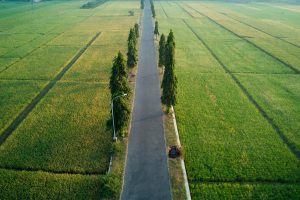Exploring the Potential of Drones in Indian Agriculture

Drones, or small unmanned aerial vehicles, are emerging as promising technology for various applications in the agricultural sector. Drones can offer several benefits to farmers, such as improving crop health, increasing yield, reducing input costs, enhancing efficiency, and saving time. Today, for this very reason, Indian farmers are keen to buy drones along with other agricultural equipment from online agriculture marketplace such as Badikheti.
In this blog post, we will explore some of the potential uses of drones in Indian agriculture and the challenges and opportunities associated with them.
Crop spraying through drones
One of the most common uses of drones in agriculture is crop spraying. Drones can be equipped with spraying mechanisms and containers to deliver pesticides, fertilizers, and water to crops. Drones can cover large areas of land in a short time and can reach places that are difficult or dangerous for humans or tractors to access.
Drones can also adjust their height and speed according to the terrain and crop type, ensuring uniform and precise application of inputs. According to some studies, drones can save up to 50% of water and 30% of chemicals compared to conventional methods of spraying.
Crop monitoring through drones
Another use of drones in agriculture is crop monitoring. Drones can be fitted with cameras and sensors to capture high-resolution images and data of crops and fields. These images and data can be processed using artificial intelligence and machine learning to generate insights on crop health, growth, yield, pests, diseases, and weeds.
Farmers can use these insights to make informed decisions on crop management and intervention. For example, drones can help farmers identify areas that need more or less irrigation, fertilization, or pest control.
Crop planting using drones
A third use of drones in agriculture is crop planting. Drones can be designed to shoot pods containing seeds and nutrients into the soil. This can reduce the labor and time required for sowing seeds and also improve the germination rate and survival rate of plants. Drones can also plant seeds in a more optimal pattern and density than manual methods.
Apart from these uses, drones can also be used for other purposes in agriculture, such as farm animal surveillance, crop insurance assessment, soil sampling, transportation of goods, and tackling locust attacks.
Drones can also provide real-time aerial imagery and data to farmers, researchers, extension workers, and policymakers for better planning and management of agricultural activities.
Field mapping through drones
Field mapping by drones in the agriculture sector is a technique that uses unmanned aerial vehicles (UAVs) to collect and analyze data on crop conditions, soil properties, and terrain features. Field mapping by drones can help farmers improve their productivity, efficiency, and sustainability by providing them with accurate and timely information for decision-making.
Some of the benefits of field mapping by drones in the agriculture sector are:
- Drones can cover large areas of land faster and cheaper than traditional methods such as satellite imagery or ground surveys.
- Drones can provide high-resolution images and videos that can reveal details such as plant health, weed density, pest infestation, nutrient deficiency, and crop yield.
- Drones can also capture elevation data that can help farmers identify drainage patterns, wet/dry spots, erosion risks, and irrigation needs.
- Drones can integrate with various sensors and software platforms that can process and analyze the data collected by drones and generate useful insights and recommendations for farmers.
- Drones can also perform other tasks such as crop spraying, seeding, fertilizing, and monitoring.
Field mapping by drones in the Indian agriculture industry is a rapidly evolving field that offers many opportunities and challenges for farmers and researchers. As drone technology advances and becomes more accessible and affordable, it is expected that field mapping by drones will become more common and beneficial for the agriculture field in the future.
Things to mind before using drones in Indian agriculture
Despite drones come with great benefits to Indian farmers in their modern agricultural practice, there are also some challenges and limitations that need to be addressed before drones can be widely adopted in the agriculture sector.
Some of the factors to mind are:
- Drones require skilled operators and maintenance staff who can ensure their proper functioning and safety.
- These machines are subject to regulations and restrictions that vary by country and region regarding their use, registration, licensing, airspace, privacy, and security.
- Drones are vulnerable to weather conditions, interference, theft, vandalism, and cyberattacks that can affect their performance and reliability.
- Drones may also pose ethical and social issues such as noise pollution, animal welfare, public perception, and legal liability.
Indian farmers may learn how to operate drones or can hire a drone expert in order to use them safely. They should also assure that their unmanned flying machines are decent and do not cause harm in any way.
Challenges and concerns of using drones in Indian agriculture
Other than a few things to mind for using drones mentioned above, there are some challenges and barriers that need to be overcome for their widespread adoption in India. Indian farmers must consult technical expertise who has sound knowledge of rules and regulations about using drones in India.
Some of these challenges are:
Regulatory framework: The use of drones in India is regulated by the Directorate General of Civil Aviation (DGCA) under the Drone Rules 2021. These rules specify the requirements for drone registration, licensing, operation, safety, security, and privacy. While these rules have been simplified and liberalized compared to the previous ones, they still pose some constraints for drone users in terms of permissions, fees, restrictions, and penalties.
Cost and availability: The cost of drones and their accessories can be high for many farmers in India, especially smallholders. Moreover, the availability of drones and their spare parts can be limited in rural areas. There is a need for more affordable and accessible drone solutions that cater to the needs and preferences of Indian farmers.
Awareness and skills: Many farmers in India may not be aware of the benefits and applications of drones in agriculture or may have misconceptions or apprehensions about them. There is a need for more awareness campaigns, demonstrations, training, and capacity-building programs to educate farmers about drones and how to use them effectively.
Infrastructure and connectivity: The use of drones in agriculture depends on reliable infrastructure and connectivity such as electricity, internet, GPS, and cellular networks. However, these may not be available or consistent in many rural areas of India. There is a need for more investment and innovation in improving the infrastructure and connectivity for drone operations.
Conclusion
Drones are emerging as a useful technology for Indian agriculture, offering various benefits such as crop monitoring, spraying, seeding, and surveying. Drones can help farmers improve their productivity, efficiency, and resource utilization, as well as reduce their costs and environmental impact.
However, there are also some challenges and limitations associated with drone use in agriculture, such as regulatory hurdles, high initial investment, technical skills, and social acceptance. Therefore, the conclusion of using drones in Indian agriculture is that they have great potential to revolutionize the sector, but they also require careful planning, implementation, and evaluation to ensure their optimal and sustainable use.






